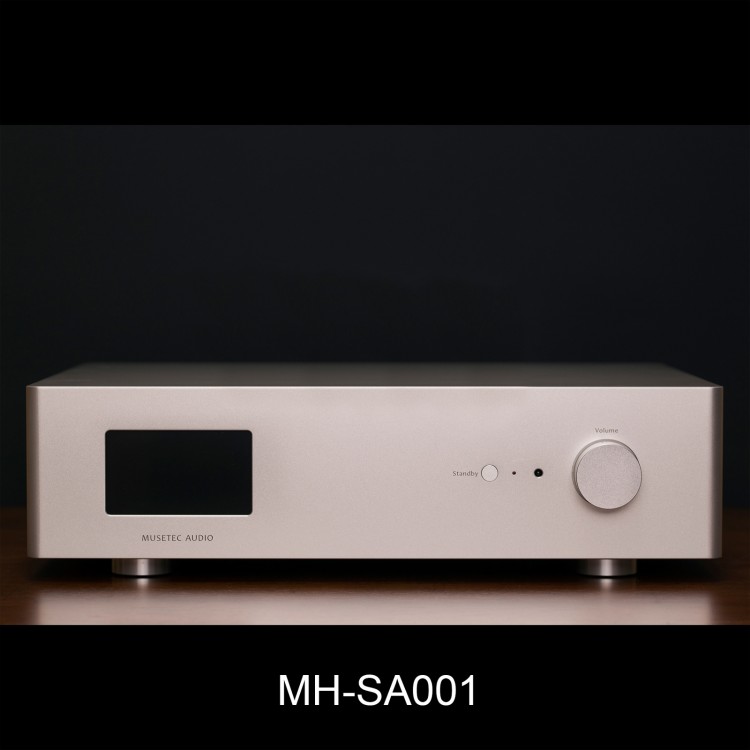
| Quantity | 3+ units | 10+ units | 30+ units | 50+ units | More |
|---|---|---|---|---|---|
| Price /Unit | $3,882.87 | $3,803.63 | $3,684.76 | $3,526.28 | Contact US |
MUSETEC MH-SA001 HiFi Preamplifier Fully Isolated Circuits Class A Audio Amplifier with 256 Volume Levels
Description:
- This preamp with fully self-developed circuitry uses 12 groups of amplifier modules working in Class A state for each channel, and different circuit parameters are set according to the respective functions in the circuit to achieve the best working state. For example, there are matched JFET input modules designed for input signal buffering, constant-current driver modules designed for volume change circuits, and high-current output modules designed for signal output.
- It is necessary to explain in particular the volume attenuation circuit, which is an extremely important part that can never be bypassed in a preamplifier. There are a variety of audio volume potentiometers on the market, such as the more common and inexpensive 16/27 type carbon film potentiometer for ALPS, medium-priced, such as film potentiometer for AN or TKD, high-grade, such as some precision resistor voltage divider type potentiometers, and then high-end, for Elma, Seiden, Amco and other brands of Attenuator Switches. In general, potentiometers have a huge impact on the sound performance, the reason for this can be attributed mainly to its high impedances of up to tens of kilohms. First, the audio signal passes through the high impedance potentiometer, then into the amplifier circuit. Too high input impedance will affect the working state of the amplifier, then affect the sound.
- We have tried to use various types of potentiometers, such as quadruple switches for Seiden and 88 AN non-inductive resistors to form a resistive attenuation network, and we used for AN silver resistors on the most commonly used gears. This should be our most "high-end" attempt, and can also be considered as some "ultimate" in traditional mechanical potentiometers. We also tried electronic volume chips, such as MUSE7232x series for NJRC. Multiplexed relay-driven resistor network potentiometers have also been used. The above-mentioned solutions, each with its own advantages and disadvantages. The volume potentiometer solution we finally used was inspired by our years experience of DAC development. We used a special modular circuit to convert the input voltage audio signal into a current type signal, and then attenuation the current signal through a constant low-resistance network. By this approach we obtained the "ideal" potentiometer we had been seeking, and we found the sound as we want. The process of implementing this circuit was "difficult and painful".
- In addition to the "ideal" potentiometer, we paid extra attention to the power supply. Poor power supply design leads to interference and signal crosstalk, resulting in a loss of sound purity and clarity. So we use 3 power transformers for the left and right channels as well as the control circuit. At the same time, we use isolators to isolate the digital control circuit and the left and right channels, and finally achieve the effect of the left and right channels and control circuit completely independent, no common ground. This completely eliminates the crosstalk between channels, and also eliminates the crosstalk between the digital control circuit and the analog circuit. Although we use a single chassis for this preamp, but the internal is completely independent of the three parts.
- We also paid special attention to the selection of power supply decoupling capacitors. We searched through dozens of capacitors for a long time listening, and finally confirmed the right match, different combinations of capacitors will also significantly change the sound. This process requires you to be very patient and to be able to enjoy the premise, otherwise it is basically impossible to complete the task.
- Thanks to the above-mentioned pursuit of extreme design, this preamplifier has an extremely full and dense sound in the full range of listening, realistic, natural, high and low frequency extension without compression, balanced energy distribution, outstanding texture, and excellent sense of line. The balanced listening experience is better than my tube preamp which was made at any cost, probably because the tube preamp use a high impedance potentiometer, it is not very natural sound.
Key Features:
- Separate all circuits of the left and right channels to achieve complete isolation.
- Design of Class A amplification circuit.
- A low resistance path current mode volume control circuit designed with discrete components.
- 256 level volume level, commonly used volume areas use a 0.25dB step resolution.
- Frequency response -1dB; 0.1Hz ~ 200Khz.
- Minimum distortion: 0.00025%.
- There are 5 optional input ports, including RCA x 3 and XLR x 2.
- There are a total of 2 output ports, with 1 RCA and 1 XLR output simultaneously.
- Support RCA input to XLR output, or XLR input to RCA output.
- Size: 430 x 390 x 122mm
- Product net weigh: 12.2kg
Package Included:
- 1 x Host